
The Devonian is a geologic period and system of the Paleozoic era during the Phanerozoic eon, spanning 60.3 million years from the end of the preceding Silurian period at 419.2 million years ago (Ma), to the beginning of the succeeding Carboniferous period at 358.9 Ma. It is named after Devon, South West England, where rocks from this period were first studied.

The Silurian is a geologic period and system spanning 24.6 million years from the end of the Ordovician Period, at 443.8 million years ago (Mya), to the beginning of the Devonian Period, 419.2 Mya. The Silurian is the shortest period of the Paleozoic Era. As with other geologic periods, the rock beds that define the period's start and end are well identified, but the exact dates are uncertain by a few million years. The base of the Silurian is set at a series of major Ordovician–Silurian extinction events when up to 60% of marine genera were wiped out.
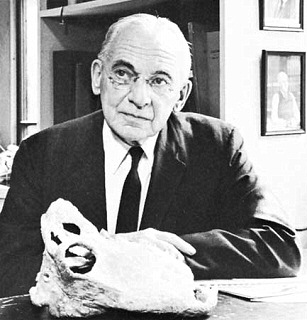
Alfred Sherwood Romer was an American paleontologist and biologist and a specialist in vertebrate evolution.

Pterygotus is a genus of giant predatory eurypterid, a group of extinct aquatic arthropods. Fossils of Pterygotus have been discovered in deposits ranging in age from Middle Silurian to Late Devonian, and have been referred to several different species. Fossils have been recovered from four continents; Australia, Europe, North America and South America, which indicates that Pterygotus might have had a nearly cosmopolitan (worldwide) distribution. The type species, P. anglicus, was described by Swiss naturalist Louis Agassiz in 1839, who gave it the name Pterygotus, meaning "winged one". Agassiz mistakenly believed the remains were of a giant fish; he would only realize the mistake five years later in 1844.

Dorothy Hill, was an Australian geologist and palaeontologist, the first female professor at an Australian university, and the first female president of the Australian Academy of Science.
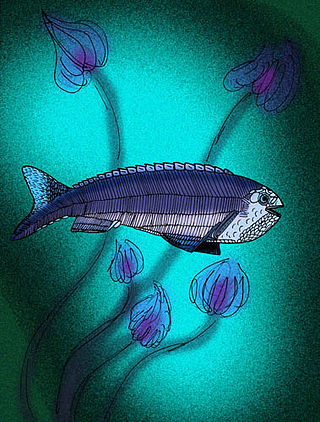
Anaspida is an extinct group of jawless fish that existed from the early Silurian period to the late Devonian period. They were classically regarded as the ancestors of lampreys, but it is denied in recent phylogenetic analysis, although some analysis show these group would be at least related. Anaspids were small marine fish that lacked a heavy bony shield and paired fins, but were distinctively hypocercal.

Dunkleosteus is an extinct genus of large arthrodire ("jointed-neck") fish that existed during the Late Devonian period, about 382–358 million years ago. It was a pelagic fish inhabiting open waters, and one of the first apex predators of any ecosystem.

Robert Etheridge FRS FRSE FGS was an English geologist and palaeontologist.
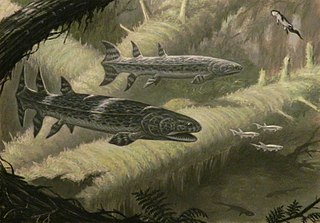
Hyneria is a genus of large prehistoric predatory lobe-finned fish which lived in freshwater during the Devonian period (Famennian).
Notopala is a genus of moderately large to large, freshwater snails with an operculum, aquatic gastropod mollusks in the family Viviparidae, the river snails or mystery snails.

Trimerophytopsida is a class of early vascular plants from the Devonian, informally called trimerophytes. It contains genera such as Psilophyton. This group is probably paraphyletic, and is believed to be the ancestral group from which both the ferns and seed plants evolved. Different authors have treated the group at different taxonomic ranks using the names Trimerophyta, Trimerophytophyta, Trimerophytina, Trimerophytophytina and Trimerophytales.
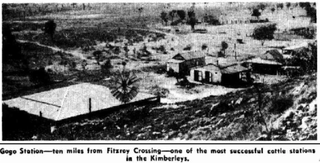
The Gogo Formation in the Kimberley region of Western Australia is a Lagerstätte that exhibits exceptional preservation of a Devonian reef community. The formation is named after Gogo Station, a cattle station where outcrops appear and fossils are often collected from, as is nearby Fossil Downs Station.
† Bembexia is a genus of fossil sea snails, marine gastropod mollusks. This genus is placed in the subfamily Eotomariinae, of the family Eotomariidae. The shell characters resemble those of Balbinipleura. These snails have been interpreted as herbivorous, probably grazing on algae.

Holonema is an extinct genus of relatively large, barrel-shaped arthrodire placoderms that were found in oceans throughout the world from the Mid to Late Devonian, when the last species perished in the Frasnian-Fammian extinction event. Most species of the genus are known from fragments of their armor, but the Gogo Reef species, H. westolli, is known from whole, articulated specimens.
† Cheeneetnukiidae is an extinct family of sea snails, marine gastropod mollusks in the clade Vetigastropoda.
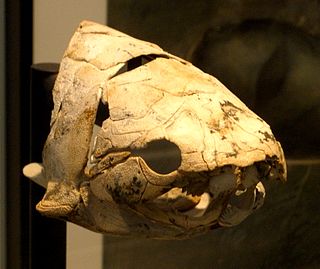
Eastmanosteus is a fossil genus of dunkleosteid placoderms. It was closely related to the giant Dunkleosteus, but differed from that genus in size, in possessing a distinctive tuberculated bone ornament, a differently shaped nuchal plate and a more zig-zagging course of the sutures of the skull roof.
Ichnomylax is an extinct genus of lungfish which lived during the Devonian period. Fossils have been found in Australia and Russia.

Incisoscutum is an extinct genus of arthrodire placoderm from the Early Frasnian Gogo Reef, from Late Devonian Australia. The genus contains two species I. ritchiei, named after Alex Ritchie, a palaeoichthyologist and senior fellow of the Australian Museum, and I. sarahae, named after Sarah Long, daughter of its discoverer and describer, John A. Long.

Africanaspis is an extinct genus of groenlandaspidid placoderm known from two species, Africanaspis doryssa, named in 1997 from fossils discovered in South Africa and Africanaspis edmountaini, named from fossils described from South Africa during 2017. A. edmountaini is only known from juvenile specimens. Both species are known from the Witpoort Formation. A. doryssa reached 23 cm (9.1 in) long.














